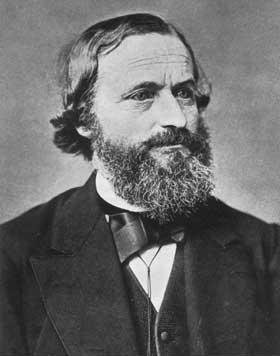Gustav Kirchhoff
claimed by fwalker2017

Gustav Kirchhoff was a German physicist who is known for his contributions to circuit laws, laws of thermal radiation, fluid dynamics equations, three laws of spectroscopy and law of thermochemistry.
Personal Life
Gustav Robert Kirchhoff was born March 12, 1824 in Kaliningrad, Russia and died 1887. He attended the Albertus University of Königsberg and graduated in 1847, accepting professorships at various universities throughout his life.During his time as a student, Kirchhoff formulated his circuit laws that are prominent in electrical engineering. During his time at University of Heidelberg, he collaborated with Robert Bunsen to study spectroscopy and they later discovered caesium and rubidium. In 1857 he calculated that an electric signal in a resistanceless wire travels along the wire at the speed of light and two years later, he proposed his law of thermal radiation. In 1862 he was awarded the Rumford Medal for his research spectroscopy, where he formalized laws that describe the spectral composition of light. He is also recognized for his solving of Maxwell’s equations which provided a basis for Huygen’s principle.
Scientific Contributions
Circuit Laws
The Current Law
Commonly referred to as the conservation of charge or node rule, the current law states that “the total current or charge entering a junction or node is exactly equal to the charge leaving the node as it has no other place to go except to leave, as nod charge is lost within the node.” Mathematically, the sum of all the current entering and leaving the nod must be equal to zero. This can be used to analyze parallel circuits. However, this law is valid only if the electric charge remains constant in the region being considered. [math]\displaystyle{ \sum {I}_{entering}+ \sum {I}_{exiting} = 0 }[/math]
Example

1. Note the direction of current flow into the circuit
2. Sum the entering currents on one side of the equation and equate it to the sum of exiting currents
[math]\displaystyle{ {i}_{2} + {i}_{3} = {i}_{1} + {i}_{4} }[/math]
The Voltage Law
Commonly referred to as the conservation of energy or loop rule, the voltage law states that “in an closed loop network, the total voltage around the loop is equal to the sum of all the voltage drops within the same loop. Mathematically, the sum of all voltages within the loop must be equal to zero. This can be used to analyze series circuit.However, this law is invalid if there is a fluctuating magnetic field linking the closed loop. [math]\displaystyle{ \Delta {V}_{1} + \Delta {V}_{2} + \space.... = 0 }[/math]
Example

1. Start at any point in the loop and continue in the same direction
2. Note the direction of the voltage drops (positive or negative)
3. Continue along the loop until you reach the starting point, adding the voltages along the path.
[math]\displaystyle{ {v}_{1}+{v}_{2}+{v}_{3}={v}_{4} }[/math]
Law of Thermal Radiation
“For a body of any arbitrary material, emitting and absorbing thermal electromagnetic radiation at every wavelength in thermodynamic equilibrium, the ratio of its emissive power to its dimensionless coefficient of absorption is equal to a universal function only of radiative wavelength and temperature. That universal function describes the perfect black-body emissive power.” The absorptivity of a body has to equal its emissivity at every wavelength. This law is further explored in thermodynamics and is established in mathematical terms by Max Planck.
Applications Today
-A matrix version of Kirchhoff’s current law is the basis of most circuit simulation software
-Kirchhoff's circuit laws are ubiquitous with electrical engineering and provides fundamental laws where circuits are more complex.
-Kirchhoff's rules can be used to analyze any circuit by modifying them for those circuits with electromotive forces, resistors, capacitors and more.
See Also
Further Reading
1. Kirchhoff, G. (1860). "Ueber das Verhältniss zwischen dem Emissionsvermögen und dem Absorptionsvermögen der Körper für Wärme and Licht". Annalen der Physik und Chemie 109 (2): 275–301. Bibcode:1860AnP...185..275K. doi:10.1002/andp.18601850205. Translated by Guthrie, F. as Kirchhoff, G. (1860). "On the relation between the radiating and absorbing powers of different bodies for light and heat". Philosophical Magazine. Series 4 20: 1–21.
2. https://en.wikibooks.org/wiki/Circuit_Theory/Kirchhoff%27s_Law
External Resources
Videos
1. Further Demonstration of Circuit Laws: https://www.youtube.com/watch?v=Z2QDXjG2ynU
Websites
1. http://www.electronics-tutorials.ws/dccircuits/dcp_4.html https://www.boundless.com/physics/textbooks/boundless-physics-textbook/circuits-and-direct-currents-20/kirchhoff-s-rules-152/applications-541-8441/
2.http://cnx.org/contents/79e288b2-b57b-49b0-96b2-e31c35581911@8/Kirchhoffs-circuit-laws